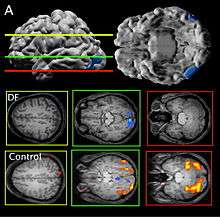Patient DF
Patient DF is a woman with visual apperceptive agnosia who has been studied extensively due to the implications of her behavior for the two streams theory of visual perception. Though her vision remains intact, she has trouble visually locating and identifying objects. Her agnosia is thought to be caused by a bilateral lesion to her lateral occipital cortex, an area thought by dual-stream proponents to be the ventral “object recognition” stream.[1] Despite being unable to identify or recognize objects, DF can still use visual input to guide her action.
Lesion

Patient DF’s brain damage resulted from hypoxia due to carbon monoxide poisoning.[2] The lateral occipital cortex in her brain is severely damaged and shows no activation presented with line drawings of common objects where healthy people usually do. There is also some shrinkage in the intraparietal sulcus, often implicated in the dorsal stream for visuomotor control. The fusiform face area is intact. This would suggest the problem in DF’s perception is disconnectivity between higher and lower order functioning.[2]
Recent MRIs have shown many enlarged sulci, like the intraparietal sulcus, parieto-occipital sulcus, and left calcarine sulcus, indicating atrophy.[2] Her visual field remains intact up to 30 degrees.[1]
Performance
Like most apperceptive agnosics, DF cannot name an object from its appearance purely or copy a line drawing. She can draw familiar objects from memory. DF can also differentiate color and patterns—given an image and its scrambled version, she can tell them apart[2]—but if shown different shapes in the same color and pattern, she is at chance at differentiating the two.[1] She can identify 67% of grayscale and color images, but only 10% of line drawings.
Despite her inability to identify objects by shape, her actions seem to reflect a deeper understanding than she reports: DF correctly orients her hand to post a letter through a slot, picks up pebble-like objects at secure grasp points, and scales her grip correctly to pick up Efron blocks( which match in surface area, texture, mass, and color, and differ only in length and width).[3]
And yet, Patient DF cannot judge the width of an object, such as a guitar pick, by using her thumb and forefinger to show how big it is. However, when asked to pick it up, her hand moves to the correct width.[1] Her estimates (she is asked to put her thumb and forefinger the correct distance apart without moving to grasp the object) still do not improve thereafter, but she continues to accurately pick up the object, indicating that she cannot judge features of the object on command but is able to control her actions with that information.
DF does not benefit from haptic feedback—allowing her to pick up an object does not let her better estimate its width next time.[3] DF also does not use visual information about her grasp: when she can only see her grip in a distorted mirror, her performance does not change.[2] Consistent with all of this, brain imaging has shown no response to line drawings in her ventral stream. Furthermore, according to fMRI studies,the intraparietal sulcus showed preference for grasping motions over reaching motions—actually grabbing an object, in both DF and control patients, activates the intraparietal sulcus more than reaching.[2]
Implications
It is safe to say that “behavioural dissociation between action and perception, coupled with the neuroanatomical and functional neuroimaging findings suggest that the preserved visual control of grasping in DF is mediated by relatively intact visuomotor networks in her dorsal stream, whereas her failure to perceive the form of objects is a consequence of damage to her ventral stream”.[2]
Along with double dissociations shown in monkeys, DF’s experience is good evidence for the two streams theory of visual perception[2] and shows that the dorsal stream alone provides information for aperture scaling.
References
- 1 2 3 4 Whitwell R. L., Milner A. D., Cavina-Pratesi C., Barat M., Goodale M. A. (2015). Patient DF's visual brain in action: visual feedforward control in visual form agnosia. Vision Res. 110, 265–276. 10.1016/j.visres.2014.08.016
- 1 2 3 4 5 6 7 8 Thomas W. James, Jody Culham, G. Keith Humphrey, A. David Milner, Melvyn A. Goodale Brain. 2003 November; 126(Pt 11): 2463–2475. Published online 2003 September 23. doi: 10.1093/brain/awg248
- 1 2 Whitwell, R. L., Milner, A. D., & Goodale, M. A. (2014). The Two Visual Systems Hypothesis: New Challenges and Insights from Visual form Agnosic Patient DF. Frontiers in Neurology, 5, 255. http://doi.org/10.3389/fneur.2014.00255